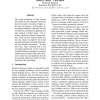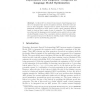118
click to vote
TASLP
2010
14 years 7 months ago
2010
Traditional n-gram language models are widely used in state-of-the-art large vocabulary speech recognition systems. This simple model suffers from some limitations, such as overfi...
99
Voted
EMNLP
2009
14 years 10 months ago
2009
The recent availability of large corpora for training N-gram language models has shown the utility of models of higher order than just trigrams. In this paper, we investigate meth...
113
Voted
ACL
2009
14 years 10 months ago
2009
Kneser-Ney (1995) smoothing and its variants are generally recognized as having the best perplexity of any known method for estimating N-gram language models. Kneser-Ney smoothing...
102
Voted
EMNLP
2010
14 years 10 months ago
2010
We present three novel methods of compactly storing very large n-gram language models. These methods use substantially less space than all known approaches and allow n-gram probab...
109
click to vote
TSD
2010
Springer
14 years 10 months ago
2010
Springer
This paper presents two different approaches to automatic captioning of geo-tagged images by summarizing multiple web-documents that contain information related to an image’s lo...
117
Voted
ICGI
2010
Springer
15 years 1 months ago
2010
Springer
Abstract. In this article, we propose the use of suffix arrays to efficiently implement n-gram language models with practically unlimited size n. This approach, which is used with ...
95
Voted
NIPS
2008
15 years 1 months ago
2008
Neural probabilistic language models (NPLMs) have been shown to be competitive with and occasionally superior to the widely-used n-gram language models. The main drawback of NPLMs...
LREC
2008
15 years 1 months ago
2008
Originally conceived as a "naive" baseline experiment using traditional n-gram language models as classifiers, the NCLEANER system has turned out to be a fast and lightw...
EMNLP
2008
15 years 1 months ago
2008
The intersection of tree transducer-based translation models with n-gram language models results in huge dynamic programs for machine translation decoding. We propose a multipass,...
124
Voted
CICLING
2003
Springer
15 years 5 months ago
2003
Springer
In this work1 we obtain robust category-based language models to be integrated into speech recognition systems. Deductive rules are used to select linguistic categories and to matc...


